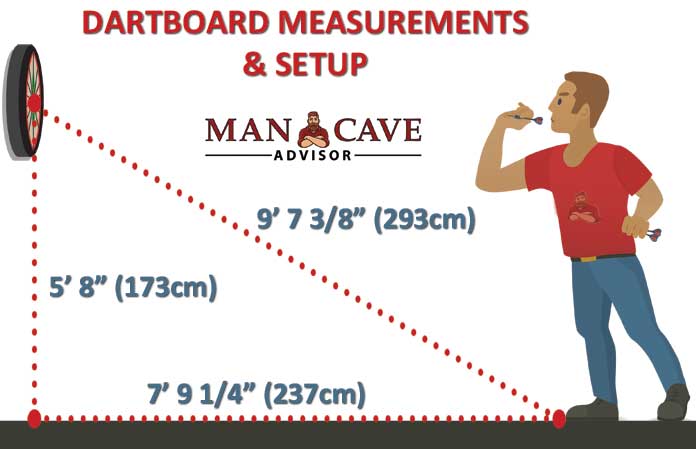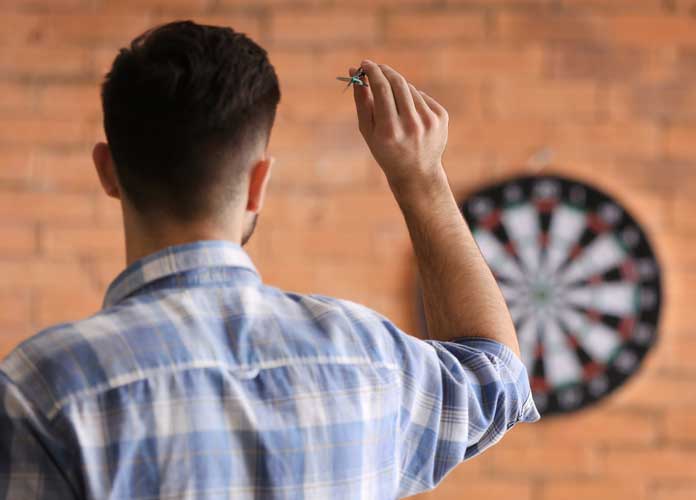The humble dartboard is hands-down one of the most practical and accessible additions to any man cave. With its classic aesthetic, dartboards add a touch of decorative appeal on top of the opportunity for hours of great, dart-tossing fun. But before you go willy-nilly with those darts, it’s worth asking – is your dartboard properly set up?
If you really want to become a dart master, it’s worth knowing that you can just stick your board on any random wall and be done with it. You have to make sure your dartboard is positioned in the right place using the proper measurements to qualify for the standards set by the National Dart Association.
So you want to give the guys the dart game challenge of a lifetime, next time they swing by your cave? Make sure you follow these set-up standards.
Deciding on a Wall
First things first – where should you place your dartboard? To make sure you’ve chosen the right wall, try asking yourself the following questions:
- Is the wall in front of a space that’s spacious enough to accommodate a dart thrower and a few of his spectator pals?
- Is it away from areas of foot traffic like hallways or areas that are usually walked around on?
- Is the area free from hanging lighting fixtures, breakables, and other pieces of decor or furniture?
- Is the wall itself sturdy, made of a durable material like solid wood or cement?
If you answered no to any of the questions above, then you might want to reconsider a few things. Basically, when deciding on the right wall for your dartboard, what you want to look out for is safety.
If you go for a freestanding dartboard, then you’ll have to measure the height and distance every time you set up the board.
There should be enough space for you and other people watching you play so you can throw your darts freely and without fear of putting anyone at risk of injury. If the area is frequently passed by people, like the space in the middle of your man-cave, then you might end up causing an accident if you toss your dart just as someone walks by. What you want is a place with minimal distractions.
Hanging light fixtures, paintings or windows flanking the dartboard on your wall, or other pieces of decor within throwing distance of your dart area can be hazardous and dangerous, especially if you or your friends are just learning how to play. The last thing you want is to break a bunch of stuff on your journey towards becoming a dart-tossing top dog.
Finally, inspect your wall of choice. Is it made of flimsy plywood? Or a durable solid wood or cement? Is it coated in a decorative paint color or wallpaper that might get damaged by a dart gone rogue? If you want to make sure that your wall isn’t ruined by your dart throwing activities, consider copping a backboard for it to protect the areas around the dart board itself.
The Global Standards for Dartboard Placement
 There are several different dart associations around the globe, and all of them have worked together to come up with standard measurements for dartboard placement and play. The purpose of the global standard is to make sure that people experience a level playing field, and so that the game offers the same challenge wherever they go.
There are several different dart associations around the globe, and all of them have worked together to come up with standard measurements for dartboard placement and play. The purpose of the global standard is to make sure that people experience a level playing field, and so that the game offers the same challenge wherever they go.
Simply put, if you make sure you practice on a dart board follows the same standards as all of the other dart boards in your favorite pubs and restaurants, then you can feel confident in your skills wherever the boys decide to challenge you next.
Distance from Dartboard to Floor
Dartboards that follow the global standards should be at a height of 5 feet and 8 inches from the floor below. This distance is measured from the center of the board – or the bull’s eye – straight down to the ground. To make the proper measurement, ask a friend to hold the board in place against the wall, and measure from its center downwards.
Distance from Dartboard to Player
The second measurement would be the distance between the dartboard and the player. For this measurement, there are two possible distances:
- For steel-tipped darts – 7 feet, 9 and 1/4 inches or 237 centimeters
- For plastic-tipped darts – 8 feet flat or 243.84 centimeters
When measuring the distance, make sure you’re measuring from the surface of the dartboard and not the wall. If you find it more convenient to measure from the wall, make sure you factor in the thickness of your dart board when it comes to your final measurement.
Because it can be tough to measure a straight horizontal line from the wall to the throwing line, there are other methods for measurement. The most popular entails measuring the distance from the bull’s eye down to the floor where the throwing line should be.
Take your measuring tape and stick the free end on to the center of your dartboard. After that, measure out the following lengths depending on the type of darts you’re using:
- Steel-tipped darts – 9 feet, 7 3/8 inches OR 293 centimeters
- Plastic-tipped darts – 9 feet, 9 3/4 inches OR 299 centimeters.
Once you’ve measured out the right distance, lay the other end of your measuring tape on the floor. This diagonal line that connects the bull’s eye to a certain point on your floor should measure either one of the lengths indicated above. From a side view, your darts area should look like a right angle triangle – the wall behind the board and the floor making a right angle, and the diagonal measuring tape its hypotenuse.
Mark the throwing area on the floor before removing your measuring tape. You can do this by marking it out with packaging tape. Make sure that the edge of the tape closest to the dart board does not overlap with the distance you’ve measured. This way, players can step on the tape without worrying about overstepping.
Final Thoughts
You probably didn’t think that so much went into creating the ideal dartboard set-up. But by following these simple rules and regulations, you can be sure that the dartboard you’ve pinned against your wall can help you practice for the big leagues. So whether you’re hoping to show the guys your new dart tossing tricks, or if you simply want to get better at the game, following these standards can help you create a space that won’t put you at a disadvantage against the other dart players around the world. If you plan an adding a dartboard wall protector later, this will change your throwing line length.

